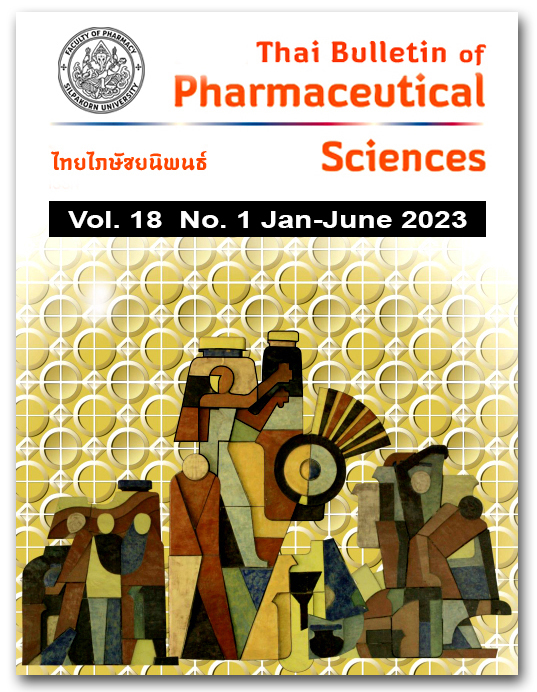การวิจัยเชิงกรณีศึกษา: การรับรู้ประโยชน์และอุปสรรคของการตรวจติดตามปริมาณของเชื้อเอชไอวีในผู้ติดเชื้อเอชไอวีที่ขาดการตรวจติดตามปริมาณของเชื้อเอชไอวีในกระแสเลือด
DOI:
https://doi.org/10.69598/tbps.18.1.107-127คำสำคัญ:
ผู้ติดเชื้อเอชไอวี, การตรวจติดตามปริมาณของเชื้อเอชไอวี, การรับรู้ประโยชน์, การรับรู้อุปสรรค, การศึกษาเชิงคุณภาพบทคัดย่อ
การตรวจติดตามปริมาณของเชื้อเอชไอวีในกระแสเลือด เป็นวิธีการติดตามการตอบสนองต่อยาต้านไวรัส และระบุความล้มเหลวในการรักษา งานวิจัยนี้เป็นการศึกษาเชิงคุณภาพในรูปแบบการวิจัยเชิงกรณีศึกษา มีวัตถุประสงค์เพื่อศึกษาการรับรู้ประโยชน์ การรับรู้อุปสรรค การรับรู้สมรรถนะแห่งตน และการสนับสนุนทางสังคมในผู้ติดเชื้อเอชไอวีที่ขาดการตรวจติดตามปริมาณของเชื้อเอชไอวีในกระแสเลือด โดยทำการสัมภาษณ์เชิงลึกในผู้ติดเชื้อเอชไอวีที่รับประทานยาต้านไวรัสต่อเนื่องอย่างน้อย 6 เดือน แต่ขาดการตรวจติดตามปริมาณของเชื้อเอชไอวีในกระแสเลือด จำนวน 10 คน ในโรงพยาบาลรัฐแห่งหนึ่งในจังหวัดทางภาคกลาง สำหรับการวิเคราะห์ข้อมูลเชิงคุณภาพทำโดยการวิเคราะห์เชิงเนื้อหา ผลการวิจัยพบว่า การขาดข้อมูลเกี่ยวกับการติดตามผลการรักษาจากปริมาณของเชื้อเอชไอวีในกระแสเลือดส่งผลให้ผู้ติดเชื้อเอชไอวีไม่รับรู้ประโยชน์ของการตรวจติดตามปริมาณของเชื้อเอชไอวีในกระแสเลือด และนำไปสู่การขาดการตรวจติดตามการรักษา ผู้ติดเชื้อเอชไอวีรับรู้อุปสรรคที่เกิดจากปัจจัยด้านบุคคลและปัจจัยด้านสิ่งแวดล้อมแตกต่างกันไป ผู้ติดเชื้อเอชไอวีกลุ่มอายุมากกว่า 60 ปีที่อาศัยอยู่นอกพื้นที่บริการของโรงพยาบาลรับรู้อุปสรรคด้านการเดินทางและค่าใช้จ่ายจากการเดินทาง ขณะที่ผู้ติดเชื้อเอชไอวีที่มีรายได้เป็นรายวันอาจรับรู้อุปสรรคด้านการขาดรายได้ ด้านสิทธิการรักษาพยาบาลจะเป็นสิ่งสนับสนุนการรับบริการของผู้ติดเชื้อเอชไอวีอย่างต่อเนื่อง สำหรับปัจจัยด้านสิ่งแวดล้อมพบว่า ช่วงเวลาการให้บริการ การนัดหมาย การจัดเก็บข้อมูลที่ไม่มีประสิทธิภาพเป็นอุปสรรคต่อการตรวจติดตาม ผู้ติดเชื้อเอชไอวีที่รับยาต้านไวรัสทุกรายมีสุขภาพแข็งแรง มีความมั่นใจในสมรรถนะแห่งตนที่จะสามารถจัดการตนเองให้มารับการตรวจติดตามได้อย่างต่อเนื่อง การสนับสนุนทางสังคมจากบุคคลใกล้ชิดมีส่วนสนับสนุนทางอารมณ์ และสิ่งของ ส่งผลให้เกิดกำลังใจและความร่วมมือในการตรวจติดตาม นอกจากนี้บุคลากรการแพทย์มีส่วนสำคัญในการให้ข้อมูลความรู้ด้านการตรวจติดตาม การกำหนดเป้าหมายในการรักษา และการนัดหมาย ซึ่งจะส่งผลสำคัญต่อความร่วมมือในการตรวจติดตามปริมาณเชื้อเอชไอวีของผู้ติดเชื้อเอชไอวีได้
เอกสารอ้างอิง
World Health Organization. (2017). HIV/AIDS. Accessed Febuary 9. Available from: https://www.who.int/features/qa/71/en/
World Health Organization. (2003). Adherence to long-term therapies: evidence for action. Accessed July 19. Available from: https://www.who.int/chp/knowledge/publications/ adherence_section3.pdf?ua=1
Joint United Nations Programme on HIV/AIDS (UNAIDS). [Internet]. Geneva: UNAIDS; 2018 [cited 2022 Nov 1]. Available from: http://www.unaids.org/en
NAP Web Report [Internet]. Bangkok: National Health Security Office; 2022 [cited 2022 Nov 5]. Available from: http://napdl.nhso.go.th/NAPWebReport/LoginServlet
Division of AIDS and STIs, Department of Disease Control. Thailand national guidelines on HIV/AIDS treatment and prevention 2021/2022. 1st ed. Bangkok: Aksorn graphic and design publishing limited partnership; 2022.
Ministry of Public Health. Essentials of HIV/AIDS treatment and prevention 2014 Thailand. 1st ed. Bangkok: The Agricultural Cooperative Federation of Thailand Limited; 2014.
Joint United Nations Programme on HIV/AIDS (UNAIDS). 90-90-90 An ambitious treatment target to help end the AIDS epidemic [Internet]. Geneva: UNAIDS; 2014 [updated 2014 Oct; cited 2018 Jan 10]. Available from http://www.unaids.org/sites/default/files/media_asset/90-90-90_en.pdf
NAP Web Report [Internet]. Bangkok: National Health Security Office; 2018 [cited 2018 Jan 5]. Available from: http://napdl.nhso.go.th/NAPWebReport/LoginServlet
Chotisen O, Praditbatuka S, Cheevakasamsook A. Factors related to people living with HIV/AIDS behaviors at Sirindhorn hospital, medical service department, Bangkok Metropolitan Administration. JRTAN. 2015;16(1): 41-50. (in Thai)
Yehia BR, Stephens-Shields AJ, Fleishman JA, Berry SA, Agwu AL, Metlay JP, et al. The HIV care continuum: Changes over time in retention in care and viral suppression. PLoS One. 2015;10(6): e0129376.
Sheehan DM, Fennie KP, Mauck DE, Maddox LM, Lieb S, Trepka MJ. Retention in HIV care and viral suppression: Individual- and neighborhood-level predictors of racial/ethnic differences, Florida, 2015. AIDS Patient Care STDS. 2017;31(4):167-75.
Berger MB, Sullivan KA, Parnell HE, Keller J, Pollard A, Cox ME, et al. Barriers and facilitators to retaining and reengaging HIV clients in care: A case study of North Carolina. J Int Assoc Provid AIDS Care. 2016;15(6):486-93.
Pender N. Health promotion in nursing practice. 5th ed. New Jersey: Pearson Education; 2006.
Kongphol J. Perceived self-efficacy and practices in preventing failure of antiretroviral treatment among HIV-Infected/ AIDS persons [Dissertation]. Songkla: Prince of Songkla University; 2011. (in Thai)
Suwanobol N, Anansawat S, Jai-ai R. Success factors and barriers to develop the caring system for people living with HIV and AIDS. J Royal Thai Army Nurses. 2016;17(1):70-8. (in Thai)
Komgla N. Predicting factors of adherence to regimens among adolescents living with HIV/AIDS [Dissertation]. Bangkok: Chulalongkorn University; 2010. (in Thai)
Saratham O. Selected factors associated with adherence to regimen among school age children living with HIV/AIDS at regional hospitals, Southern Thailand [Dissertation]. Bangkok: Chulalongkorn University; 2008. (in Thai)
Fleishman JA, Yehia BR, Moore RD, Korthuis PT, Gebo KA; HIV Research Network. Establishment, retention, and loss to follow-up in outpatient HIV care. J Acquir Immune Defic Syndr. 2012;60(3):249-59.
De La Mata NL, Ly PS, Nguyen KV, Merati TP, Pham TT, Lee MP, et al. Loss to follow-up trends in HIV-positive patients receiving antiretroviral treatment in Asia from 2003 to 2013. J Acquir Immune Defic Syndr. 2017;74(5):555-62.
Zhou J, Tanuma J, Chaiwarith R, Lee CKC, Law MG, Kumarasamy N, et al. Loss to followup in HIV-infected patients from Asia-pacific region: Results from TAHOD. AIDS research and treatment. 2012:375217.
Berheto TM, Haile DB, Mohammed S. Predictors of loss to follow-up in patients living with HIV/AIDS after initiation of antiretroviral therapy. N Am J Med Sci. 2014;6(9):453-9.
Chalermpichai T. Prevalence of loss to postpartum follow-up in mothers with HIV infection and associated factors. TJNC. 2008;23(1):48-59. (in Thai)
Chalermpichai T, Ratintorn A, Sindhu S, Ratanasuwan W, Reynolds N. Factors associated with the retention in care after delivery among Thai mothers with HIV.” Pacific Rim Int J Nurs Res. 2016;20(3):225-37. (in Thai)
Sanjobo N, Frich JC, Fretheim A. Barriers and facilitators to patients' adherence to antiretroviral treatment in Zambia: a qualitative study. SAHARA J.. 2008;5(3):136-43.
Chamaleak V, Tangyingyong T, Watanachai Y. Efficacy study of HIV/AIDs patient care development system. MEDICAL Med J Sisaket Surin Buriram Hosp. 2018;29(1):29-40. (in Thai)
Rutstein SE, Golin CE, Wheeler SB, Kamwendo D, Hosseinipour MC, Weinberger M, et al. On the front line of HIV virological monitoring: barriers and facilitators from a provider perspective in resource-limited settings. AIDS Care. 2016;28(1):1-10.
Yin RK. Case study research: Design and methods (Applied social research methods). 5th ed. CA: SAGE Publications, Inc; 2013.
Connelly CE. Self-care and the chronically ill patient. Nurs Clin North Am. 1987;22(3):621-9.
Thanwong T, Pensirinapa N. Factors related to medical care usage of chronic disease patients at sub-district health promoting hospitals in Khao Yoi Health Network, Petchaburi Province. J Saf Health. 2016;9(31):26-36. (in Thai)
Wongputh P. Stigma in people living with HIV/AIDS [Dissertation]. Chiang Mai: Chiang Mai University; 2002. (in Thai)
Veerakul K. Factors affecting the cooperation of treatment behavior among HIV Infected/AIDS patients attending antiretroviral therapy program at Thung Tako hospital, Chumphon Province [Dissertation]. Nonthaburi: Sukhothai Thammathirat Open University; 2011. (in Thai)
Tina A. Effects of empowerment together with social supports to health behaviors among HIV infected persons and AIDS patients currently receiving anti-retroviral in Sansai hospital, Chiang Mai. Lanna Public Health Journal. 2011;7:221-3. (in Thai)
Hirandit A. Strategies to improve adherence to antiretroviral therapy. In: Preecha M, Sonthisombat P, Vimolsarawong N, Pattharachayakul S, Editors. Handbook for pharmacists caring for HIV and AIDS patients. 1st ed. Bangkok: Prachachon Co., Ltd; 2007. 311-40.
Bandura A. Self-efficacy: The exercise of control: Worth Publishers; 1997.
Aneksak W, Daenseekaew S. Community-based support on self-management among people living with HIV in a university in northeastern, Thailand. J Nurs Health Care. 2019;37(4):72-9. (in Thai)
Wilson D, Keiluhu AK, Kogrum S, Reid T, Seriratana N, Ford N, et al. HIV-1 viral load monitoring: an opportunity to reinforce treatment adherence in a resource-limited setting in Thailand. Trans R Soc Trop Med Hyg. 2009;103(6):601-6.



